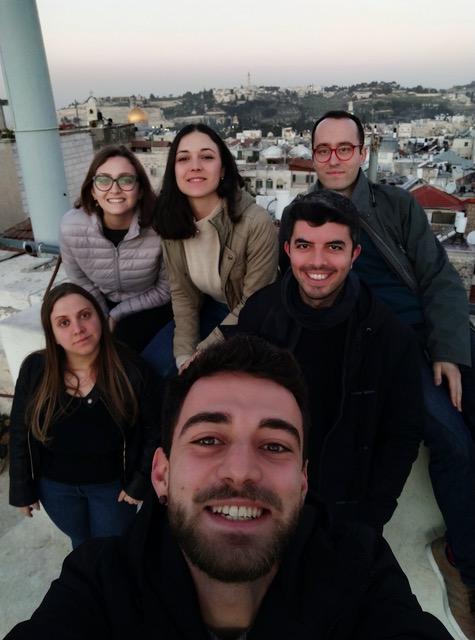I write from a very special, privileged place. A large terrace, I'd say... white. A rectangle bordered by massive stone walls, about one and a half meters high.
Without even trying too hard, my eyes fall in rhythm, proceeding clockwise, on the "Franciscan church of the Saviour with its slender bell tower with a black tip, which is the tallest bell tower in the whole city". (Fürst, Geiger). They linger, full of wonder, on the Dome of the Rock, in Arabic Qubbat as-Sakhra. A golden hemisphere that seems to concentrate the highest possible number of solar rays. Both the clear, warm, spring day and the cloudy, cold, autumn day. Already trained eyes can see the Protestant church of the Savior with its quadrangular bell tower and Hurva synagogue. The background is that of the Mount of Olives. On the clearest and luckiest days you can catch a glimpse of Jordan.
I left the Holy Sepulchre for last. Let me say that even today, in the midst of this storm, of this pandemic, remains the heart of the world.
Without overdoing it with rhetoric, I believe that the young people who came to Jerusalem during a global pandemic are aware that they have to rebuild. Just as the basilica of the Holy Sepulchre has always stood up, thanks to the intervention of the faithful who, tirelessly, have venerated it since time immemorial, we must also use this period of pause and forced reflection to create, organize and rebuild.
Annalisa, Azzurra, Daniela, Fabio, Pierfilippo and I arrived in the Holy Land on February 3, 2020 thanks to the Universal Civil Service, a program promoted by the Presidency of the Council of Ministers and realized thanks to the collaboration between the University of Bari Aldo Moro and the Pro Terra Sancta Association.
The aid worker, the architect, the archaeologist, the art historian, the philologist and the legal. We are beginning to fit into the complex reality of the Holy Land from both a professional and personal point of view.
Without delay, on March 17, 2020 we move from offices, museums and libraries to the so-called "lockdown". Movements become limited. Until the day before it was possible to put on a pair of sneakers and leave the hectic pace of the city to abandon oneself before sunset from the church of Dominus Flevit. Suddenly you can only leave the house for necessary work, health and food shopping.
The thoughts turned to Italy, to affections, but begins the reorganization of what will be our world until the date to be destined.
The alarm clock is followed by a press review and a strong coffee.
We work remotely precisely to create, organize and rebuild, but above all to manage the health emergency in a territory as beautiful as fragile. Health structures, social entrepreneurship projects, construction sites, prayers cannot and must not stop. It would be an inconceivable surrender that we cannot afford.
In the evening we train a little, perhaps on that terrace that is still a lifeline.
The only chance to go out is, wearing gloves and a mask, to do a quick shopping a few meters from the door in the middle of Via Dolorosa. The pilgrims have been replaced by disconsolate traders. From the typical voice of the Old Town we pass to the cat meowing. From crowd to desert. "What a special situation" a friend would say.
Dinner follows in company. Everyone brings his region to the table, from the Alps to Aspromonte. The messages of Giuseppe Conte, the prayers of the Pope, break in a little to keep us with our feet on the ground a little to keep hope alive.
Late (we are an hour ahead of Italy) we make a few phone calls at home, read a book or watch a movie. Everything inside those rooms that, due to the abundance of time available and the desire to make them beautiful, have become even more welcoming.
At the Maria Bambina, the structure of the Custody of the Holy Land managed by the Sisters of Charity, so someone remained, despite everything. Each one with his or her own history, but a participant in this parallel world.


















